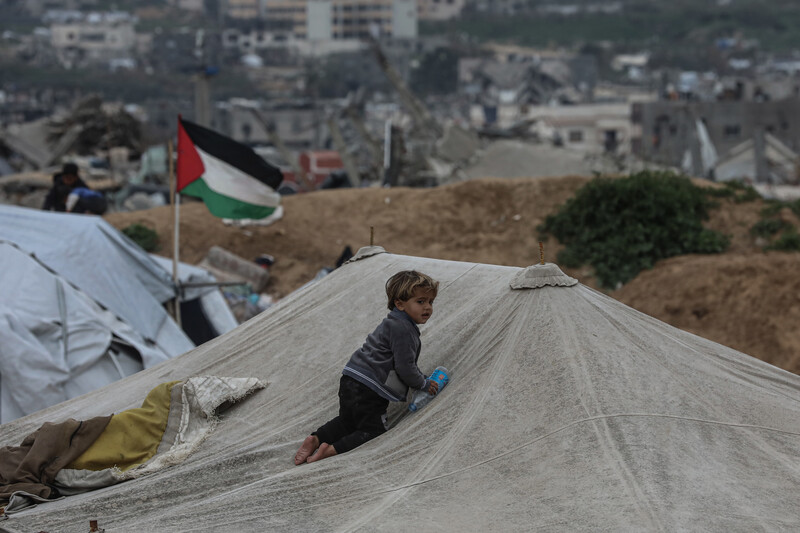21 February 2025

Displaced Palestinians live in makeshift tents among the rubble of buildings destroyed by Israeli attacks, Beit Lahiya, Gaza, 19 February.
The following is from the news roundup during the 20 February livestream. Watch the entire episode here.
Israel has committed more than 260 violations of the ceasefire terms since it came into effect on 19 January.
According to Palestinian security sources, these violations include targeting Palestinians who are returning to their homes, targeting civilian vehicles and heavy equipment, carrying out incursions and bulldozing operations in the eastern areas, demolishing homes in the southern city of Rafah, flying drones across Gaza outside the hours specified under the terms of the agreement, and carrying out more than 130 aircraft sorties overhead.
Euro-Med Human Rights Monitor this week documented Israeli quadcopter drones broadcasting recorded messages intending to threaten and frighten Palestinians in Gaza. Some of the messages warn of a “second and third Nakba,” referring to the initial expulsion of Palestinians from their land in 1948.
Ismail al-Thawabta, the director-general of the Gaza government media office, stated that Gaza is still waiting on the arrival of temporary homes and shelters for displaced families, which Israel is obligated to allow in under the ceasefire agreement.Heavy machinery, including bulldozers and earth movers required to clear the rubble and repair critical infrastructure, is also being held up by Israel at the crossings. Al-Thawabta told the Turkish Anadolu Agency that Israel has only allowed six small vehicles to remove rubble from the Gaza Strip while preventing the entry of hundreds more that are desperately needed.
He said that Gaza needs at least 500 heavy equipment vehicles, including bulldozers, excavators and cranes.
And the scale of the devastation of vital infrastructure is enormous.
Gaza’s public works ministry issued a wide-ranging report this week assessing the extent of Israel’s catastrophic destruction of apartment buildings and homes across the enclave since October 2023.According to the ministry, approximately 170,000 housing units have been destroyed and 80,000 housing units remain unfit for habitation. The number of completely demolished or severely damaged housing units is expected to exceed 280,000.
Meanwhile, the international agency Oxfam reports that Israel “balks” in approving the necessary supplies to repair or replace the nearly 1,700 kilometers of water and sanitation networks that have been destroyed.
Oxfam stated this week that “the picture remains extremely bleak and dangerously critical, especially in the North Gaza and Rafah governorates.”
Less than 7 percent of pre-genocide water levels are available to people, which the group says is heightening the spread of waterborne diseases.
“As fragile ceasefire negotiations hang in the balance, any renewed violence or disruption to fuel and the already inadequate aid would trigger a full-scale public health disaster,” Oxfam states.
Attacks on Palestinian security workers
At the same time, Israel has continued to attack and kill aid workers and security forces who are accompanying the aid that is being let into Gaza.
On Sunday, Israel targeted police officers who were securing aid distribution east of Rafah.In a statement, Hamas said that the airstrike constituted another grave violation of the ceasefire agreement.
“This crime, along with this breach of the ceasefire, adds to the occupation’s ongoing refusal to uphold the terms of the agreement. The latest example of this was the occupation’s statement today, declaring that it will not allow the entry of mobile homes and heavy machinery, despite previously committing to doing so and informing mediators of this agreement at the end of last week,” Hamas stated.Dr. Hussam Abu Safiya shown in shackles
Israeli media released a video on Wednesday of armed and masked Israeli guards leading the director of Kamal Adwan Hospital, Dr. Hussam Abu Safiya, a pediatrician, in handcuffs and leg shackles, ostensibly at Ofer Prison where he has been held since early January.
Abu Safiya was abducted by Israeli soldiers from his hospital, along with his colleagues and patients, on 27 December.
Israeli TV channel 13 broadcast an interview with Abu Safiya at the prison, and, according to his family, “deliberately rephrased and distorted” his statements.Abu Safiya’s family added, “The footage broadcast by Israeli media of our father, Dr. Husam Abu Safiya, the director of Kamal Adwan Hospital, is yet another form of psychological terrorism, adding to the torture he has endured over the past two months. It also reflects clear media distortion through the manipulation and alteration of his statements.”
One month of West Bank assault
Turning to the occupied West Bank, The Electronic Intifada’s Tamara Nassar reports that alongside Israel’s systematic campaigns of forced displacement of Palestinians under a widespread, massive assault dubbed Operation Iron Wall, its colonial settlement expansion is accelerating.
Nassar writes that in Jenin refugee camp, for example, testimonies gathered by the United Nations human rights office include accounts from residents who were told by Israeli forces that they would not be allowed to return to the refugee camp.
Some residents reported being told by Israeli forces to “forget” the refugee camp.
The agency even reported receiving photos from Jenin refugee camp showing “freshly bulldozed roads with new signs apparently giving several streets Hebrew names.”
Nassar adds that during the course of Israel’s Operation Iron Wall, which is approaching its one-month mark, Israel has killed at least 44 Palestinians, including children, and injured many others, according to the UN human rights office. Other human rights groups have estimated the number killed to be higher.
The military assault, a coordinated effort involving Israel’s military, domestic spy agency Shin Bet and Israel’s Border Police, includes the deployment of Israeli snipers in residential neighborhoods, home raids, the arrest of youth, aerial bombardments and the destruction of buildings and critical infrastructure, such as water, electricity and sewage systems.
Israeli forces killed a Palestinian child on 12 February in the Nur Shams refugee camp and then confiscated his body.
A 15-year-old Palestinian boy died on 17 February from wounds he sustained three weeks before when he was hit by shrapnel from an Israeli drone strike targeting a nearby vehicle.
Meanwhile, Israel has attacked several schools for Palestinian children in refugee camps across the West Bank, as part of its plan to close the operations of the UN agency for Palestine refugees, UNRWA.
In occupied Jerusalem, Israeli police raided the Jerusalem Elementary School in Silwan, right outside the gates of the Old City, on Tuesday.According to witnesses, Israeli forces interrogated school administrators, including the principal, during the attack. A boys’ school in the Wadi al-Joz neighborhood was targeted, as Israeli forces expelled students from their desks and forced the staff to close the school.
Israeli troops also raided and stormed a vocational training school in Qalandiya refugee camp, firing tear gas and sound bombs with 350 students and 30 staff present.
Highlighting resilience
Finally, as we always do, we wanted to share images of people expressing determination and resilience in the aftermath of Israel’s 15-month campaign of destruction.
Last weekend, 22-year-old Adel Tayseer Sobeih was released from Israeli detention as part of the prisoner exchange. He was abducted by Israeli forces from al-Shifa Hospital in Gaza City in March 2024.
According to Al Jazeera, at some point during his 11-month detention, he was chained to a hospital bed for 50 days.
He recounts his abuse and torture at the hands of Israeli forces, and says that because of severe torture, his leg was amputated against his will.
Adel says that he can’t believe he was back in Gaza. He says that the Israelis told him over and over again that Gaza was “finished,” and that he can’t believe that there are people still alive here.
“Even yesterday, they were still saying that Gaza is finished,” he says. “Long live Palestine, we broke the ego of all of Israel, we thank its people, its women, its men, its children.”
And journalist and researcher Maha Husseini filmed this scene from the Gaza shoreline, with the caption, “Good morning from Gaza.”





Add new comment